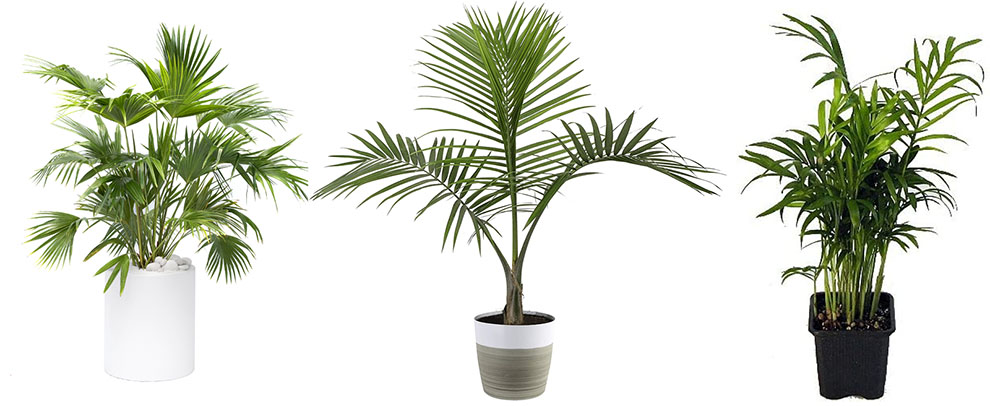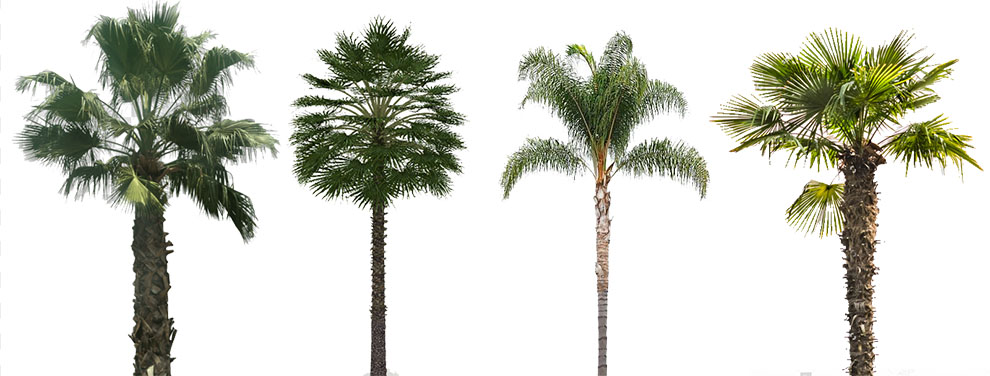Different Kinds of Palm Trees and Plant Types

If you want to add a little tropical charm to your home, a palm tree is just what you need. The lush looks of this species can spruce up any corner of your home, be it indoors or outdoors.
You have different types of palm trees that are quite easy to care for. They prefer warm temperatures, moderate light, average humidity and reasonable watering. However, these requirements change according to the variety, size and location of the plant.
In order to choose the perfect palm variety for your house, you must know about the variety of palm trees. Here are a few popular indoor and outdoor palm varieties that you can consider bringing home!
In This Article
- 5 Palm Tree Indoor Plant Types
- 5 Popular Kinds of Palm Trees Outdoor
- How To Care For A Palm Plant
- Frequently Asked Questions
Which Are The Different Types Of Palm Trees Indoors?

Other than being aesthetically pleasing, palms plants are believed to be effective in cleaning the air in your homes. These different types of palm plants are a great choice for indoor plants.
1. Areca Palm
Botanical name: Dypsis lutescens
Areca palm has several other names including Bamboo Palm, Yellow Palm, Butterfly Palm and Golden Cane Palm.
It features soft, light green fronds and can range from anywhere between 4 feet to 12 feet tall when mature.
Caring Tips:
- These palm tree indoor plants thrive in adequate humid conditions and bright indirect sunlight.
- Do not overwater them.
- The plant can tolerate low light.
- To keep it lush, feed it fertilizers monthly and make sure the soil is fertile.
2. Chinese Fan Palm
Botanical name: Livistona chinensis
This slow-growing variety of plants can reach up to the mature height of 10 or more. Also known as the Fountain Palm, these plants have a long taproot and hence it is best to put them in a large pot.
It’s star-shaped/fan-shaped leaves are a unique feature that makes it different from other palm varieties. The plant also features broad elegant emerald green foliage.
Caring Tips:
- This plant prefers bright indirect light. However, younger plants do well in shady locations as well.
- Water only when the top of the soil is dry.
- Use slow-release fertilizer to feed the plant once a year (during spring).
3. Majestic Palm
Botanical name: Ravenea rivularis
This palm variety is quite shade resistant and grows pretty slowly, making it an ideal indoor plant. The only drawback is the plant requires constant humidity and moisture. Check out some other indoor water plants here.
Its upward arching, bright green or dark green leaves can add more charm to any dull and boring space.
Caring tips:
- This plant prefers bright indirect light. However, it does well in low-light conditions as well.
- The majesty palm soil should be kept moist constantly.
4. Parlor Palm
Botanical name: Chamaedorea Elegans
Parlor Palm’s ability to thrive as a houseplant is quite evident from its name. also known as Neanthe Bella Palm, it can grow in average indoor temperatures and light, adapts to low or even in artificial light settings, and requires minimum pruning.
The plant features fine-textured, light green leaves and grows up to attain a height of 2 to 6 feet.
Caring tips:
- Avoid direct sun. parlor palms thrive in indirect light.
- These plants require uniformly moist soil, so water regularly.
- Avoid overwatering.
- The plant needs to be protected from cold drafts.
- Above-average humidity is ideal for Parlor palm.
- Avoid very dry conditions as the plant may end up attracting spider mites.
5. Ponytail Palm
Botanical name: Beaucarnea recurvata
If you’re looking for different types of palm trees for décor purposes, this should be your pick. This ornamental palm is also known as Bottle palm or Elephant’s Foot palm.
This succulent (yup..it’s not a true palm variety) is a great option for decorating the corners, tabletops, countertops, and nightstands.
What’s unique about this variety are its delicate arching leaves and its short, sturdy foot-like trunk. This indoor plant can help purify the air and is also drought-tolerant. When kept indoors, it can attain a height of anywhere between less than 1 foot to over 6 feet.
Caring Tips:
- This drought-tolerant variety requires occasional watering (once every 1 or 2 weeks.
- Avoid overwatering.
- It thrives in sunny locations.
- It grows well in indirect sunlight but best in full sun.
Popular Kinds of Palm Trees Outdoor – Have A Look!

Now we have palm trees list that can be a great addition to your backyard, garden or patio. Here are 5 different types of palm plants that you can grow outdoors.
1. Date Palm
Botanical name: Phoenix dactylifera
With its thick trunk, sprawling green fronds and large bunches of sweet fruits, the presence of a date palm is nothing short of commanding. This variety of palm trees can grow as tall as 80 feet.
This slow grower prefers a hot, sunny and dry climate. The pale-yellow flowers produced by the tree turn into clusters of dates. If you plan to reap its fruits, you’ll have to plant both male and female trees.
If you just want to enjoy the presence of a stately tree with thick foliage without any harvest, you don’t need to look further at different types of palm trees. Just plant one of these.
Caring Tips:
- Date palms prefer full sun and sandy, well-drained soil.
- Although it can tolerate light shade, this variety thrives in a full-sun position.
- New date palm trees need more water than older ones.
- Mature trees are drought-tolerant but need more water during the flowering and fruiting season in order to produce a healthy crop.
2. Mediterranean Fan Palm
Botanical name: Chamaerops humilis
Mediterranean Fan Palm or European Fan Palm are a hardy palm variety, which features multiple trunks. It is generally grown in clumps with up to 5 separate trunks or stems.
Its fronds are about 2 feet wide and triangular in shape and have gray-green, blue-green or blue-green leaves. This palm is a slow grower and can reach up to a height of 20 feet when mature.
Caring Tips:
- This variety of palm trees prefers full sun to moderate shade.
- It is hardy and can endure low temperatures.
- Although drought resistant, it requires moderate watering, especially during summer.
3. Queen Palm
Botanical name:Syagrus romanzoffiana
This royal palm variety features a smooth and straight trunk and glossy plume-like fronds. Its orange-red fruits may end up creating quite a mess when they drop. This is why it may not be a good idea to plant this palm near a patio, pool or path. Queen Palms can be up to 50 feet or more in height when mature.
Caring Tips:
- Queen palms thrive in warm regions.
- This plant prefers ample moisture in the soil.
- It grows well in acidic soil.
- It requires regular fertilization to grow well.
- The turf should be kept away from the trunk in order to prevent decay.
4. Windmill Palm
Botanical name: Trachycarpus fortune
Windmill Palms come with slim trunks and fan-shaped leaves that are about 3 feet long. The color of the pinnate fronds ranges from dark green to yellow-green. Home gardeners often prefer this variety as a patio tree or for landscaping. This slow-growing palm can reach up to 20 to 40 feet in height.
Caring Tips:
- Windmill palms are hardy and can be grown in three ways.
- They grow well in semi-shady or shady locations.
- This variety of palm trees grows well in most soils and pH levels, as long as there is good drainage.
- The delicate leaves of this palm might get damaged during strong winds. Hence, it is advisable to plant this palm in a location that is somewhat sheltered from strong winds.
- Newly planted windmill palms require regular watering. Older plants need to be watered once or twice a week.
- This variety requires a slow-release fertilizer two times a year (spring and summer/fall).
5. Foxtail Palm
Botanical name: Wodyetia bifurcate
This adaptable, fast-growing palm variety is quite popular among landscapers and nurserymen, especially in regions with a warmer climate. Since it is tolerant of salty sea spray and wind, this palm is the perfect choice for people living near ocean fronts or other regions that are salt prone.
Foxtail palm is fast-growing and features lush and feathery fronds. On maturity, it can reach up to a height of 20 feet or more.
Caring Tips:
- This variety of palm trees is somewhat drought resistant. Once established, foxtail palm requires minimal watering.
- Water regularly until the tree is established, to promote optimum growth.
- The plant thrives in a variety of soils as long as it is well-draining and not too acidic.
- This palm variety prefers full sun exposure.
- Regular fertilization is required to promote rapid growth.
How To Care For A Palm Plant?

Different types of palm trees have varied requirements. However, the basic needs of the most popular varieties are quite similar. These tips can help you care for your palm plant the right way, in order to assure healthy growth.
Caring tips for indoor palm trees:
- Keep your plant in partial shade or in an area that gets indirect sunlight. Full direct sunlight may hamper the leaves of your palm.
- Stay on the lookout for pests like mealybugs and spider mites. Take immediate action if you notice a pest invasion.
- Palms require a balance of moisture and humidity to thrive. Keep the palm plant moist but avoid overwatering since it can lead to root rot.
- Ensure healthy growth by keeping your pots adequately drained of excess water.
- Prune off dead brown leaves to keep your palm healthy.
- Do not cut the top off the plant since it can cease growth.
- Feed your plants specialized palm fertilizers or general houseplant fertilizers a few times a year.
Caring for different kinds of palm trees outdoors:
- Palm trees prefer full sun but are tolerant to some shade.
- Newly planted trees must be watered deeply two times a week until they are established.
- Once they are established, reduce the frequency of watering,
- Though different types of palm trees have different requirements for food. Ideally you should apply a slow-release fertilizer in early spring.
- If your soil does not have enough nutrients, give your palm fertilizers again in early fall.
- Wrap the trunks with frost cloth or burlap to prevent damage during cold harsh winters.
- Prune away the browning or yellowing old fronds.
- Avoid trimming the branches too close to the trunk while pruning.,
Related Read: How long does a palm tree live?|How far apart to plant palm trees? |How to tell if a palm tree is dead?
Frequently Asked Questions
Q 1. What is the most common palm?
Ans. Known for its magnificent appearance and effective air purifying quality, the Areca plant is perhaps the most common variety of palm trees. It is quite easy to grow and can be kept indoors as well as outdoors.
The list of different types of palm plants that are quite popular among home gardeners also includes Kentia Palm, Parlor Palm, Windmill Palm, Pygym date Palm, Broadleaf Lady Palm and Chinese Fan Palm. It depends on the variety of palm how fast they grow.
Q 2. Which palms like the full sun?
Ans. Different types of palm trees that thrive in the sun are Adonidia, Alexander Palm, Fan Palm like Chinese Palm and Silver Saw Palmetto, Pindo Palm, Pygmy Date palm, and Bismarck Palm.
Q 3. How to identify a small palm tree?
Ans. Small palm trees are identified through the shape of their fronds (leaves) and the type of trunk they have. Palm tree leaves can broadly be divided into 2 categories-pinnate (feather-like) or palmate (fan-like).
Several dwarf plants come with smooth and slender trunks while others feature husky trunks that appear somewhat spiky. Different palm species have different appearances.
Some consist of slender trunks with a lush crown of arching leaves. Other palm varieties come with thick, hairy and rough trunks. A few of these miniature palm varieties have a bush-like, clumping growth and a barely-visible trunk.
Q 4. How do palm trees reproduce?
Ans. Palm trees are a diverse species but all kinds of palm trees reproduce using palm tree seeds. It is the only way to reproduce for the varieties that feature a single trunk. In the case of palm varieties that branch or cluster, an offset (branch) can be used to root and form a new plant.
Q 5. What is the easiest palm tree to grow?
Ans. Parlor palms are considered to be one of the easiest palm varieties to grow indoors. These thrive in average temperature and light and do not need much care. Kentia Palm is another variety that can grow well in various indoor conditions.
Other kinds of palm trees that make low maintenance house plants include Areca Palm, Pygmy Date Palm, Ponytail Palm, and Majesty Palm. Easy to grow outdoor palm varieties include King Palm, Pineapple Palm, Date Palm, and Piru Queen Palm.
Q 6. What palms grow well in pots outside?
Ans. Different types of palm plants that grow well in pots outside are Chinese Fan palm, Jelly Palm, Silver Saw Palmetto, Mexican Blue Palm, Adonidia, Bismark Palm Lipstick Palm and Chestnut Dioon.
Q7. Do palm trees need a lot of water?
Ans. Different types of palm trees have different watering requirements. The water requirement of a palm tree depends on its size, variety and location. Generally speaking, palms tend to prefer moist soil, which means they need to be watered adequately. Do not let them go without watering for more than 2 weeks.
Q 8. Can you keep palm trees in pots?
Ans. Yes, palm trees can be grown in pots indoors as well as outdoors. Several palm trees make ideal, low-maintenance house plants and thrive in containers. However, usually, these palms do not attain their full height on maturity.
Q 9. What is the prettiest palm tree?
Ans. A few kinds of palm trees that are known for their majestic beauty include Cat Palm, Butterfly Palm, Chinese Fountain Palm, Canary Island Date Palm, Parlor Palm, Queen Palm, Lady Palm and Fishtail Palm.
Q 10. What is the most expensive type of palm tree?
Ans. Coco de Mer Palm is considered to be the most expensive variety of palm trees, owing to factors like scarcity and difficulty of growing. Depending upon its size, the plant can cost anywhere between $300 and $9000.
Q 11. What is a double palm tree called?
Ans. A double palm tree is formed when the trunk of a palm tree splits but both sides continue to grow. It has two tops and is also known as a double trunk tree or double-headed palm tree.
Q 12. How can you tell if a palm tree is male or female?
Ans. The shape and size of spathes produced in different types of palm trees differ in male and female. Also, you can tell a tree is female when it starts bearing fruits.
Q 13. What kind of palm tree has thorns?
Ans. There is a variety of palm trees with thorns that can cut right through your skin. Different types of palm plants that have thorns include Phoenix Palm, Wine Palm, Date Palm and Barbel Palm.
